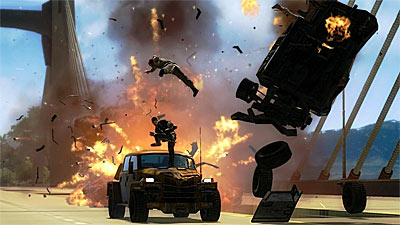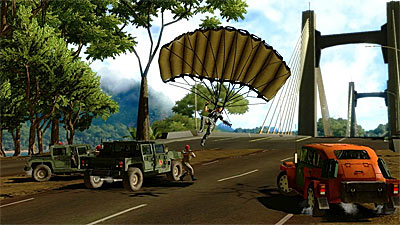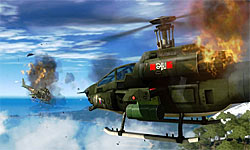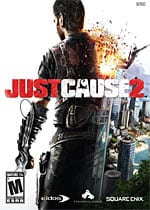Wreaking Havoc, Making Chaos!
Just Cause 2 is all about running around and having fun with loads of toys and things that go boom. If you go into this game thinking you’re going to get some seminal epic, you’re in for a surprise. Just Cause 2 is a tongue-in-cheek look at espionage video games. This guerilla simulator lets players raise hell in an immense open-world practically any way they want, and the results are sure to bring a smile to your face.

Wherever you go, you’ll find all sorts of things and people to destroy. Whether spitting death by launching rockets from a helicopter or grapple hooking a hapless enemy to a moving vehicle, you’ll want to get creative in the ways you dispatch your foes. As such, this game is filled with hilarious combat most action gamers will really enjoy. Unfortunately, it also comes with its fair share of unpolished bits that the abundant humor simply can’t cover up completely.
The first 15-30 minutes of Just Cause 2 is a clear example of how not to make a video game. The introduction is filled with lots of things that plague the title throughout. For starters, this is where you’ll be introduced to the cliché characters and lowbrow plot; I don’t think I’ve ever cared less about a game’s story – something about ‘The Agency’ hunting down a dangerous American in a nationalistic tropical island rife with pretenders to the throne. Making matters worse, the poor narrative is exacerbated by the loathsome dialogue and painful delivery. Some may argue that the developers tried to make the game cheesy in these regards in order to accentuate the humoristic approach the gameplay takes, but I’m here to squash those claims – the story, characters, and voice acting utterly fail.
Thankfully, the run-and-gun action is often exceptionally fun. There are lots of different weapons to use, and delivering death in cruel and unusual ways soon becomes second nature. Perhaps the biggest reason for the off-the-wall combat is the dual grapple hook in Just Cause 2. Imagine romping through 3-D environments with Bionic Commando-like abilities. Now imagine pulling off grapple swings, hitching to vehicles, and zipping to locations that are over a hundred yards away! Moreover, pulling enemies out from behind turrets and immediately riddling them with bullets will not only net you special kills, but is ever so satisfying. Better yet, hooking two enemies together will produce kills that look like they were taken straight out of a Three Stooges short. My favorite type of kill is, what affectionately call, the dead man’s rocket. That’s when you hook a goon to a propane tank, shoot a hole in it, and watch the poor guy get launched 50 ft. in the air just to fall to his death – not surprisingly, it never seems to get old.

The dual grapple hook is also an excellent way to get around combat zones. Rather than simply running from place to place, you’ll be better served by zipping from building to building like some kind of mutant monkey. You’ll be able to get in and out of combat in a flash, and get yourself into advantageous positions simply by aiming for the building tops. Of course, the grapple hook is only one way to get around. You’ll also have access to a parachute that can be engaged on the fly at almost any moment. If you’re driving a car at full speed and want to ghost-ride it into a group of unsuspecting soldiers without getting hurt, go ahead and open up your chute and watch the carnage unfold. Need to hijack a VIP’s limo stealthily? Try launching off a bridge with a motorcycle and gliding down on top of the vehicle. Between the grapple hook and the parachute, standard missions and mundane combat are made fresh and addictive.
As good and as game-changing as these gameplay workings are, combat is held back significantly by the poor shooting and cover mechanics. This game essentially does away with any of the technical shooting skills gamers have developed in FPS and TPS titles over the years in favor of a user-friendly, cinematic approach. As long as your gun is pointed in the vicinity of an enemy (or multiple enemies, for that matter), you’ll turn him into Swiss cheese. While this forgiving tact makes pulling off aerial kills and other stunts a breeze, it also dumbs down the encounters. Additionally, the lack of any kind of sticky cover means you’ll always take out enemies head-on and out in the open; there’s no such thing as stealth kills or isolating opponents in Just Cause 2.

Another of the game’s foibles is the difficulty in getting around the expansive world. As good as zipping around the combat zones can be, getting from one point of an island to another is extremely slow. This is due to a number of factors. First, the vehicles are cumbersome (even after upgrading them). Driving, flying, and boating around the hilly, overgrown, and obstacle-laden land, seas, and skies of Panau is painful. Second, the world is so big, you’ll sometimes go nearly 10 kilometers (6 miles) to get to your next objective. Even in a chopper, this can take upwards of five minutes – in a quad, car, or rickshaw/golf cart you’re looking at 20 minutes, minimum! Needless to say, you’ll spend hours of your precious playing time just trying to navigate from one point to the next.
In an attempt to ameliorate this, you can call up a black market dealer and get extracted from your current position to your desired location. While they let you call upon this glorified shuttle service as much as you want (and for free), it only really works if you’ve already been to the location. That’s because you can’t select “undiscovered” destinations; at best you’ll be able to select an adjacent region. As a result, I often found completing objectives to be too time-consuming and frequently became discouraged. This was especially so when I’d die in the middle of a mission and was sent all the way back to one of the safe-house hubs – talk about infuriating!

Despite the inefficiencies inherent to negotiating a massive open-world, Panau is a great place to get your guerilla on. I liken the varied terrain (encompassing beaches, urban zones, factories, villages, refineries, fortresses, jungles, air strips, mountains, etc.) to a locale out of a skating game (e.g. Skate’s San Vanelona) – Panau is essentially a warrior’s playground. There are literally thousands of nooks and crannies to discover. By exploring the world in detail, you’ll get access to weapon and vehicle parts (for upgrading your arsenal via the black market dealer) as well as get nifty health boosts. There is something extremely satisfying about heading to an undiscovered location and finding all of the hidden goodies – it must be the OCD in me.
In addition to upgrade chests, you’ll also find cash stashes that can be used to purchase new equipment. Cold, hard cash isn’t the only form of currency in the game, however; Chaos is every bit as valuable. By taking out government vehicles and emplacements (radio towers, gas tanks, satellite arrays, holding tanks, transformers, etc.) you’ll be awarded with ever-increasing Chaos totals. The more Chaos you unleash on Panau, the more faction and agency missions as well as back market items become available. This Chaos currency system is perfect for rewarding players that explore their surroundings, but it can get to be tedious and feel like a pointless grind for those that just want to move the story forward.
Whether you’re playing the game on PC, Xbox 360, or PS3, you’ll be treated to a beautiful, if somewhat unrealistic, time. The Southeast Asian archipelago of Panau isn’t exactly as lived in or as sensible as I would have liked, but it is a great place to play, nonetheless. The Pilipino vibe the developers were obviously going for comes through, but I would have liked to have seen a bit more dingy – Panau definitely doesn’t look like a country struggling under the yoke of an oppressive regime and torn apart by disparate warring factions.
Undoubtedly, the game is attractive, but the visuals also suffer from atrocious physics (at times, you’ll swear you were on the moon). The ragdoll death animations and the unrealistic, unpredictable crashes constantly remind you just how preposterous this game can be (don’t get me started on how you can effortlessly sprint up sheer hillsides). On the bright side, the poor physics and occasionally terrible animations do make for many amusing moments, but I would have liked them to be a bit more grounded from a gameplay perspective.
If there was one word I had to use to describe Just Cause 2, it would be ‘ridiculous’. The game never takes itself seriously, which, for the most part, is a good thing. However, sometimes this lackadaisical approach extends into areas where it shouldn’t, resulting in an often unpolished, even amateurish experience. Still, the game has fun in spades, so all who pick it up are likely to have a total blast!
RATING OUT OF 5 RATING DESCRIPTION 3.9 Graphics
The varied island environments of Panau are beautiful, but the laughable physics and frequent poor animations keep the visual score down. 3.5 Control
Piloting vehicles is not good at all, and the shooting and cover mechanics are weak. However, the game still manages to be great fun in spite of these problems. 2.5 Music / Sound FX / Voice Acting
The background themes nicely evoke the one-man-army agent feel, but the voice acting is brutal throughout! 4.4 Play Value
The huge world and hilarious moments means you’ll have hours upon hours of fun to look forward to. 3.9 Overall Rating – Good
Not an average. See Rating legend above for a final score breakdown.
Game Features:
